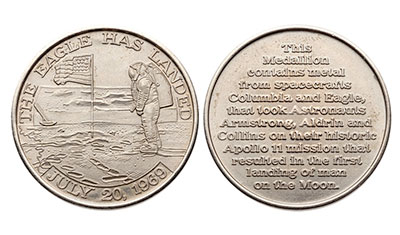posted 09-18-2018 03:11 PM




Here is a little more background about the Manned Flight Awareness (MFA) Apollo 11 medallions:In late 1962, Dr. Wernher von Braun was getting concerned about what could go wrong when the first Apollo lunar missions will be getting underway.
A young biochemist professor and researcher at Auburn University had been recruited by NASA a year earlier. His name was Dr. Preston T. Farish, a native of Beatrice, in southwest Alabama. He went to work at NASA's Marshall Space Flight Center and attended a group meeting at the Huntsville space center in which von Braun addressed the above remarks.
"I know we can design and build a vehicle to go to the moon," Farish remembers the legendary rocket pioneer saying in that early meeting. "But what bothers me is what if some guy just goofs up and blows the whole thing up."
Farish described his job at that time as a spaceflight "human expert." He explained further that he was in charge of the biological aspect of the astronaut program. Anything to do with the astronauts, Farish said, it was my task to interface with them.
So the director of MSFC asked his "human expert" to look for a solution to the possible concern or problem of human error. That's exactly what Farish did, in launching a story that lives today in hundreds of thousands of special memento-participation medallions.
But he first wanted to see how bad the problem was. Farish got a reluctant Air Force to give him figures that showed 60% of missile system failures could be linked to human screw-ups. He took those figures and report findings back to von Braun in 1963.
"He said, in effect, "You started it; you finish it," Back in his office, Farish slowly went over the five human senses, looking for reasons that workers "goof up" when they're building parts of a rocket ship. Even a psychologist was consulted on the project, Farish added. After all was said and worked on during the study, he concluded that just some "plain common sense" was needed.
What Farish finally came up with was known as NASA's Manned Flight Awareness program. The idea was if workers knew how important their work was, they would take extra care.
But credit for the early beginnings of the MFA program must include Dr. D. Brainerd Holmes, director of NASA's Office of Manned Space Flight, Washington, D.C., along with technical writer Mitchell Sharpe of MSFC working with von Braun.
It was Holmes that first suggested to von Braun that an employee motivation program would be helpful during the formative years of our nation's manned space program. He put von Braun in charge of it.
At the request of Farish, Sharpe, an Auburn alumnus co-worker of his, helped Farish during the early formation period of the MFA offices that had been established at the major field space centers in Huntsville, Houston, and the Cape area.
During the last year of NASA's Mercury orbital spaceflight period, the new program actually got started as the Mercury Awareness Program. It was, however, very limited in scope and budget. After Project Mercury had ended, the program was renamed Manned Flight Awareness, later as Space Flight Awareness, and now-a-days also as Zero Defects.
"We wanted to get the message across that you've got to have pride in what you're doing because it's part of a national program that's going to make history, Farish once told a reporter.
To get that important message across, however, he felt he needed some bigger names than himself. He told von Braun there are two people I need: you and the astronauts! Von Braun told Farish, "you got me and the astronauts."












